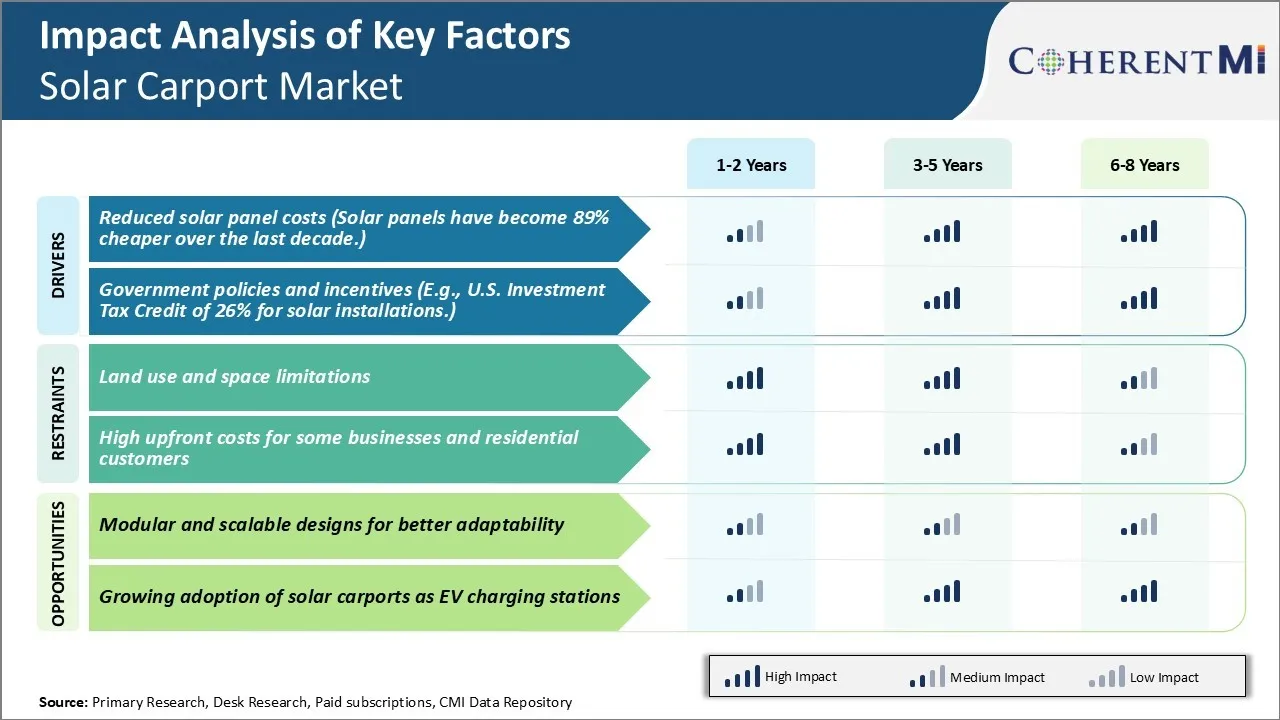Solar Carport Market Trends
Market Driver - Reduced Solar Panel Costs
The costs of solar panels and associated components have declined drastically over the past decade. Solar panels today cost around 89% less than they did ten years ago which has made installing solar carports a very attractive proposition. The upfront installation costs, which were previously a major barrier for adoption, have come down tremendously. This has lifted one of the biggest roadblocks for businesses and homeowners who were reluctant to invest in solar earlier due to high initial capital outlay.
As solar panel production has increased massively worldwide, manufacturers have been able to reduce costs by leveraging automation, supply chain efficiencies and incremental innovations. Also, Chinese manufacturers entering the solar carport market in a big way have led to cut-throat competition which has continually pushed panel prices southwards.
All these factors have aligned to bring the levelized cost of solar electricity at par with or even below than grid power prices in many areas. For solar carport owners, the low costs mean they can recover their investment in a shorter time period through energy savings. This contributes to making solar carports a very attractive long term investment proposition.
Market Driver - Government Policies and Incentives
Government policies around the world have played a pivotal role in boosting the adoption of solar energy solutions like carports. Major countries have introduced attractive demand incentives, project subsidies, tax credits and renewable portfolio standards to drive the transition to clean energy.
In the United States, the Federal Investment Tax Credit provides a 26% tax credit for commercial and residential solar installations which includes carports. This helps lower the upfront costs significantly. Many state governments also provide additional incentives in the form of rebates, property tax exemptions, low interest loans etc. These types of incentives have encouraged widespread deployment of solar carport projects.
For businesses, the tax credits can help maximize returns on solar carport investments. The supportive policy environment assures return on investments and creates long term certainty for wider adoption. As policies strengthen renewable energy goals over time, the solar carport market continues to grow from strength to strength.

Market Challenge - Land Use and Space Limitations
One of the key challenges faced by the solar carport market is lack of available land and space for large scale installations. As solar carports require substantial horizontal surface area for panel installation, they consume significant real estate space. This becomes a major hindrance especially in densely populated urban areas where availability of unused land is limited.
Property owners often hesitate to set up carports due to concerns over sacrificing existing parking or garden areas. High population densities also mean more compact property sizes with little to no additional space for renewable structures. Addressing land use concerns and optimizing space utilization will be important for the long term growth of the solar carport market.
Manufacturers may need to explore innovative structural designs that minimize footprint without compromising on generation capacities. Local governments could also help by offering policy support and incentives and identifying appropriate public lands for commercial solar carport projects.
Market Opportunity - Modular and Scalable Designs for Better Adaptability
One significant opportunity available for solar carport manufacturers is to design their products and solutions in a modular and scalable way. Customers have varying needs based on factors like location, budget, required capacity and available space.
A key way to make carports more appealing for these diverse application scenarios is to develop flexible, modular solutions that can be easily adapted. Panthers need to offer standardized building blocks and framing systems that allow for customized configurations. Individual rows or sections should be capable of being added or removed depending on the installation area. Power outputs too must be scalable through incorporating the right number and type of panels.
Modular designs will empower customers to right-size their carports and invest in renewable energy in a phased manner. They also improve transportability and speed of installation. This adaptability can help carports gain wider acceptance across different segments of the solar carport market.